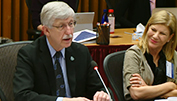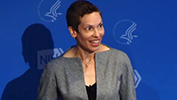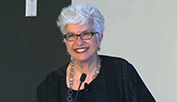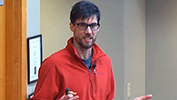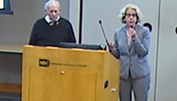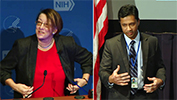-
- NIH VideoCast - Muscular Dystrophy Coordinating Committee - April 2018
-
- - NINDS, NIH (2018/05/02)
- - Category : National Institute of Neurological Disorders and Stroke
- The Muscular Dystrophy Community Assistance, Research, and Education Amendments of 2001 ("MD-CARE Act"; P.L. 107-84) authorized the establishment of the Muscular Dystrophy Coordinating Committee (MDCC) to ??????coordinate activities across the National Institutes and with other Federal health programs and activities relating to the various forms of muscular dystrophy.??? The membership of the MDCC includes representatives from various Federal agencies and voluntary health organizations.
For more information go to https://meetings.ninds.nih.gov/meetings/April2018/
NIH VideoCast - Muscular Dystrophy Coordinating Committee - April 2018
-
- NIH VideoCast - NIH Advisory Committee on Research on Women`s Health - April 2018
-
- - ORWH, NIH (2018/05/01)
- - Category : Advisory Board Meetings and Workshops
- The Advisory Committee on Research on Women`s Health meets twice a year to advise the ORWH director on appropriate NIH research activities on women`s health, review the women`s health research portfolio for NIH, survey goals for scientific career development, and assess inclusion of women and minorities in NIH clinical research.
NIH VideoCast - NIH Advisory Committee on Research on Women`s Health - April 2018
-
- NIH VideoCast - JATS-Con 2018 (Day 2)
-
- - NCBI, NLM, NIH (2018/05/01)
- - Category : Conferences
- JATS-Con is a conference for anyone who uses, or is interested in learning about, the Journal Article Tag Suite (JATS), an XML format for marking up and exchanging journal content.
For more information go to https://jats.nlm.nih.gov/jats-con/
NIH VideoCast - JATS-Con 2018 (Day 2)
-
- NIH VideoCast - CC Grand Rounds: 1) Localized Bladder Cancer: Management, Challenges, and Clinical Trials and 2) Advanced and Metastatic Bladder Cancer: Management, Challenges, and Clinical Trials
-
- - 1) Piyush K. Agarwal, MD Investigator and Head, Bladder Cancer Section, Urologic Oncology Branch, NCI, NIH and 2) Andrea B. Apolo, MD Investigator and Lasker Clinical Research Scholar; Chief, Bladder Cancer Section, Genitourinary Malignancies Branch, NCI, NIH (2018/05/01)
- - Category : Clinical Center Grand Rounds
- CC Grand Rounds: 1) Localized Bladder Cancer: Management, Challenges, and Clinical Trials and 2) Advanced and Metastatic Bladder Cancer: Management, Challenges, and Clinical Trials
For more information go to http://www.cc.nih.gov/about/news/grcurrent.html
NIH VideoCast - CC Grand Rounds: 1) Localized Bladder Cancer: Management, Challenges, and Clinical Trials and 2) Advanced and Metastatic Bladder Cancer: Management, Challenges, and Clinical Trials
-
- NIH VideoCast - Interagency Autism Coordination Committee - April 2018
-
- - NIH (2018/05/01)
- - Category : Interagency Autism Coordinating Committee
- The Interagency Autism Coordination Committee in Thursday, April 19, 2018
For more information go to https://iacc.hhs.gov
NIH VideoCast - Interagency Autism Coordination Committee - April 2018
-
- NIH VideoCast - Clinical Center Research Hospital Board Meeting - April 2018
-
- - Office of the Director, NIH (2018/05/01)
- - Category : Advisory Board Meetings and Workshops
- Clinical Center Advisory Board Meeting
For more information go to https://ccrhb.od.nih.gov
NIH VideoCast - Clinical Center Research Hospital Board Meeting - April 2018
-
- NIH VideoCast - Towards Minimally-invasive or Non-invasive Approaches to Assess Tissue Oxygenation Pre- and Post-Transfusion Workshop (Day 1)
-
- - NHLBI and OASH (2018/05/01)
- - Category : Special
- The goal of this workshop is to discuss potential next steps to facilitate the development of new technologies and/or biomarker panels to assess tissue oxygenation in a minimally to non-invasive fashion pre- and post-transfusion of Red Blood Cells (RBCs). The 2015 Transfusion Symposium identified tissue oxygenation assessment as a priority area. The development of minimally to non-invasive procedures to accurately measure tissue oxygenation are needed 1) pre-transfusion to predict who would benefit from RBC transfusions, and (2) post-transfusion to determine if the patient did benefit (and to be able to test the differential effects of various RBC products with specific characteristics). The meeting goals support the NIH mission to enhance patient health.
This workshop will build on a previous initiative focused on assessment tools to evaluate the dynamic changes in microvascular blood flow and tissue oxygenation in clinical research applications. Subject matter experts in multiple disciplines relevant to tissue oxygenation (transfusion, critical care, cardiology, neurology, neonatal/pediatrics, bioengineering, biochemistry, imaging) will generate recommendations on what the next research priorities would be to combine global ???omics??? signatures with additional measures (e.g., thenar eminence reading or imaging methods) to predict who needs RBC transfusion and evaluate whether RBC transfusion was effective and to what degree. A formal summary of the recommendations identified during the workshop will be provided in a report on the NHLBI website.
NIH VideoCast - Towards Minimally-invasive or Non-invasive Approaches to Assess Tissue Oxygenation Pre- and Post-Transfusion Workshop (Day 1)
-
- NIH VideoCast - Reframing the Primary Care Management of Chronic Pain
-
- - Erin E. Krebs, MD, MPH, Associate Professor of Medicine, University of Minnesota Medical School (2018/05/01)
- - Category : National Center for Complementary and Integrative Health
- The National Center for Complementary and Integrative Health (NCCIH) presents the integrative Medicine Research Lecture Series. The series provides overviews of the current state of research and practice involving complementary health approaches and explores perspectives on the emerging discipline of integrative medicine. Erin E. Krebs, MD, MPH, Associate Professor of Medicine, University of Minnesota Medical School, is our guest speaker for this lecture.
For more information go to https://nccih.nih.gov/news/events/IMlectures
NIH VideoCast - Reframing the Primary Care Management of Chronic Pain
-
- NIH VideoCast - Wiring the Developing Eye to the Brain for Binocular Vision
-
- - Carol Mason, Ph.D., Columbia University, College of Physicians and Surgeons (2018/05/01)
- - Category : Neuroscience
- NIH Neuroscience Series Seminar
In Dr Mason lab???s studies of axon guidance in the visual pathways, they analyze the behaviors, cellular interactions and molecular directives of retinal axon growth cones during avoidance and crossing of the midline at the optic chiasm. This system is a model for axon navigation at the CNS midline, and for patterning the binocular projection. They have identified a molecular program of transcription factors and guidance receptors that regulate cell identity and projection of the ipsilateral retinal axon pathway through the optic chiasm. Current work aims to investigate transcriptional regulators and guidance mechanisms for the contralateral projection, and mechanisms of growth cone interactions with cells of the chiasm midline.
They have recently addressed whether the programs of gene expression that direct retinal axon decussation at the optic chiasm are relevant to the formation of connections of retinal axons in their first target, the lateral geniculate nucleus. They now aim to identify molecular regulators of axon-targeting and retinal ganglion cell axon arbor morphogenesis, and to analyze the interplay of molecular factors and neural activity in the targeting and refinement of eye-specific projections.
A genetic model for these studies is the albino. In both humans and rodents, lack of pigment in the eye leads to visual impairment due to the misrouting of retinal fibers at the optic chiasm to contralateral rather than ipsilateral targets. Albinism is caused by diverse genes controlling melanogenesis. They aim to study how factors in the melanogenic pathway from the retinal pigment epithelium (RPE) affect retinal patterning, and retinal ganglion cell specification and projection fate.
For more information go to https://neuroscience.nih.gov/neuroseries/Home.aspx
NIH VideoCast - Wiring the Developing Eye to the Brain for Binocular Vision
-
- NIH VideoCast - Towards Minimally-invasive or Non-invasive Approaches to Assess Tissue Oxygenation Pre- and Post-Transfusion Workshop (Day 2)
-
- - NHLBI and OASH (2018/05/01)
- - Category : Advisory Board Meetings and Workshops
- The goal of this workshop is to discuss potential next steps to facilitate the development of new technologies and/or biomarker panels to assess tissue oxygenation in a minimally to non-invasive fashion pre- and post-transfusion of Red Blood Cells (RBCs). The 2015 Transfusion Symposium identified tissue oxygenation assessment as a priority area. The development of minimally to non-invasive procedures to accurately measure tissue oxygenation are needed 1) pre-transfusion to predict who would benefit from RBC transfusions, and (2) post-transfusion to determine if the patient did benefit (and to be able to test the differential effects of various RBC products with specific characteristics). The meeting goals support the NIH mission to enhance patient health.
This workshop will build on a previous initiative focused on assessment tools to evaluate the dynamic changes in microvascular blood flow and tissue oxygenation in clinical research applications. Subject matter experts in multiple disciplines relevant to tissue oxygenation (transfusion, critical care, cardiology, neurology, neonatal/pediatrics, bioengineering, biochemistry, imaging) will generate recommendations on what the next research priorities would be to combine global ???omics??? signatures with additional measures (e.g., thenar eminence reading or imaging methods) to predict who needs RBC transfusion and evaluate whether RBC transfusion was effective and to what degree. A formal summary of the recommendations identified during the workshop will be provided in a report on the NHLBI website.
NIH VideoCast - Towards Minimally-invasive or Non-invasive Approaches to Assess Tissue Oxygenation Pre- and Post-Transfusion Workshop (Day 2)
-
- NIH VideoCast - Biowulf Seminar: Structure, dynamics and function of intrinsically disordered proteins from experiment and molecular simulation
-
- - Robert B. Best, Ph.D., NIDDK, NIH (2018/05/01)
- - Category : Special
- Biowulf Seminar Series
Intrinsically disordered proteins are recognized to play key biological roles, however current structural biology and simulation techniques are often poorly suited to characterizing them. Experimental methods such as F??rster resonance energy transfer (FRET), nuclear magnetic resonance (NMR) spectroscopy and small-angle X-ray scattering (SAXS) can all yield useful information, but are averaged over a very heterogeneous structural ensemble, making interpretation difficult. Here, I illustrate how molecular simulation can be used as an aid in determining a molecular model reflecting the structural and dynamic properties observed in experiment. In particular, I will focus on the recently discovered example of two intrinsically disordered proteins which bind with 1:1 stoichiometry to form a complex with nanomolar affinity mediated by the opposing charges of the molecules. Coarse-grained molecular simulations with a simple empirical potential are able to explain a range of FRET and NMR data for the complex. Remarkably, they reveal that both proteins remain essentially completely disordered when bound -- results which are backed up by independent all-atom simulations of the same complex. This raises the question of how frequent such fully disordered complexes may be in biology.
For more information go to https://hpc.nih.gov/training
NIH VideoCast - Biowulf Seminar: Structure, dynamics and function of intrinsically disordered proteins from experiment and molecular simulation
-
- NIH VideoCast - Evidence that DNA polymerase ?? contributes to initiation of leading strand DNA replication in Saccharomyces cerevisiae
-
- - Dr. Marta Garbazc, NIEHS, NIH (2018/05/01)
- - Category : DNA Repair
- DNA Repair Interest Group videoconference
Young Investigator Showcase
NIH VideoCast - Evidence that DNA polymerase ?? contributes to initiation of leading strand DNA replication in Saccharomyces cerevisiae
-
- NIH VideoCast - Liver-kidney organs-on-a-chip reveal distant site for bioactivation of human carcinogen
-
- - Dr. Viktoriya S. Sidorenko, Assistant Professor, Department of Pharmacological Sciences, Laboratory of Chemical Biology, Stony Brook University (2018/05/01)
- - Category : DNA Repair
- DNA Repair Interest Group videoconference
Young Investigator Showcase
Acrobat Slides
NIH VideoCast - Liver-kidney organs-on-a-chip reveal distant site for bioactivation of human carcinogen
-
- NIH VideoCast - 2018 Demystifying Medicine: Prenatal Genomics and Fetal Gene Therapy
-
- - Diana Bianchi, MD, NICHD, NIH and Alan De Cherney, MD, NICHD, NIH (2018/05/01)
- - Category : Demystifying Medicine
- Demystifying Medicine
Technologies to not merely detect fetal abnormalities but to treat them in utero at the earliest stages of human development have merged and are poised to improve pregnancy outcomes and the long-term health and wellbeing of the baby.
Two leaders in this challenging new field ??? NICHD Director Diana Bianchi, M.D., and NICHD Senior Investigator Alan Decherney, M.D. ??? discuss the remarkable advances in recent years, such as understanding fetal and placental biology through sequence analysis of nucleic acids that circulate within the pregnant woman`s blood, collected noninvasively. Although such advances hold great promise, they are coupled with thorny ethical issues concerning the efficacy of treatment and proper safeguarding of data.
Widely used methods to detect fetal abnormalities include imaging and placental biopsies. Noninvasive prenatal DNA testing is now in the vanguard of genomic medicine and has revolutionized prenatal care globally and has created new opportunities for personalized medicine for the fetus. The technique is based on detection of prenatal DNA in cells isolate from the mother???s circulation during pregnancy. There is need for pretest education for all pregnant women and consistent post-test management recommendations for those with discordant results. Prenatal DNA testing has had profound effects on diagnosis and management of fetal abnormalities. However, the accumulating datasets of genomic information on pregnant women and their fetuses raises ethical issues concerning data-mining and intellectual property.
For more information go to https://demystifyingmedicine.od.nih.gov
NIH VideoCast - 2018 Demystifying Medicine: Prenatal Genomics and Fetal Gene Therapy
-
- NIH VideoCast - Interagency Coordinating Committee on Fetal Alcohol Spectrum Disorders (ICCFASD) - April 2018
-
- - National Institute on Alcohol Abuse and Alcoholism, NIH (2018/05/01)
- - Category : Advisory Board Meetings and Workshops
- General public Interagency Coordinating Committee on Fetal Alcohol Spectrum Disorders (ICCFASD) (open to the public)
For more information go to http://www.niaaa.nih.gov/ICCFASD
NIH VideoCast - Interagency Coordinating Committee on Fetal Alcohol Spectrum Disorders (ICCFASD) - April 2018
-
- NIH VideoCast - Hearts, Spiders, and Relaxation: Voyages in Hypertrophic Cardiomyopathy
-
- - Christine Seidman, M.D., Thomas W. Smith Professor of Medicine and Genetics, Harvard Medical School and Brigham and Women???s Hospital (2018/05/01)
- - Category : Special
- The NHLBI 70th Anniversary Lecture Series is designed to highlight not only significant advancements in the field of heart, lung, blood, and sleep research, but to also provide a visionary perspective of the promising opportunities ahead including addressing some of the most compelling questions and critical challenges elicited in the 2016 NHLBI Strategic Vision.
Dr. Seidman is the founding Director of the Cardiovascular Genetics Center at Brigham and Women???s Hospital. Her research aims to discover genes, mutations, and mechanisms for human heart muscle disorders. She has identified genetic causes for hypertrophic cardiomyopathy and dilated cardiomyopathy, defined the consequences of mutations on biophysical properties of cardiac muscle, and described cell and molecular responses to these abnormalities.
For more information go to https://www.nhlbi.nih.gov/events/2018/70th-Anniversary-Lecture-Series-2
NIH VideoCast - Hearts, Spiders, and Relaxation: Voyages in Hypertrophic Cardiomyopathy
-
- NIH VideoCast - CC Grand Rounds: New Findings in Genetic Bone Diseases 1) X-linked Form of Osteogenesis Imperfecta Caused by Defective Intramembrane Proteolysis and 2) Cracking the "Tough Nut": Somatic Mutations in the Candle Wax Bone Disease Melorheostosis
-
- - 1) Joan Marini, MD, PhD,Senior Investigator, Section on Heritable Disorders of Bone and Extracellular Matrix, NICHD, NIH and 2) Timothy Bhattacharyya, MD, Head, Clinical and Investigative Orthopaedic Surgery, NIAMS, NIH and Director of Orthopaedic Trauma, Suburban Hospital (2018/05/01)
- - Category : Clinical Center Grand Rounds
- CC Grand Rounds:New Findings in Genetic Bone Diseases" 1) X-linked Form of Osteogenesis Imperfecta Caused by Defective Intramembrane Proteolysis and 2) Cracking the "Tough Nut": Somatic Mutations in the Candle Wax Bone Disease Melorheostosis
For more information go to http://www.cc.nih.gov/about/news/grcurrent.html
NIH VideoCast - CC Grand Rounds: New Findings in Genetic Bone Diseases 1) X-linked Form of Osteogenesis Imperfecta Caused by Defective Intramembrane Proteolysis and 2) Cracking the "Tough Nut": Somatic Mutations in the Candle Wax Bone Disease Melorheostosis
-
- NIH VideoCast - Sensing from within: how the immune system discriminates friend from foe
-
- - Katherine A. Fitzgerald, Ph.D., Director, Program in Innate Immunity, Worcester Foundation Chair in Biomedical Research, and Professor of Medicine, University of Massachusetts Medical School (2018/05/01)
- - Category : WALS - Wednesday Afternoon Lectures
- NIH Director`s Wednesday Afternoon Lecture Series
Rolla E. Dyer Lecture
Established in 1950 in honor of former NIH director Dr. Rolla E. Dyer, a noted authority on infectious diseases. The lectureship, part of the NIH Director`s Wednesday Afternoon Lecture Series, features internationally renowned researchers who have contributed substantially to medical as well as biological knowledge of infectious diseases.
The central goal of Dr. Fitzgerald`s research is understanding the molecular mechanisms controlling the inflammatory response and defining how the immune system discriminates between pathogens and host molecules to avoid damaging inflammatory diseases.
Our health relies on the ability of the immune system to mount timely and selective responses to dangerous microbes. For example, the immune system must respond aggressively to pathogens yet avoid responding to harmless commensals that line our skin and mucosal surfaces. While we have learned a lot about the receptors that recognize microbial products, the central question in immunity remains: How does the immune system discriminate friend from foe?
A central theme that has emerged from Dr. Fitzgerald`s work over the last decade is that nucleic acids represent a primary means of alerting the immune system to the presence of pathogens. But beneficial commensals and our own cells contain nucleic acids, too. She believes that the location of nucleic acids allows the immune system to discriminate friend from foe. Accumulation of nucleic acids in cytosolic compartments is perceived as a danger signal during infection. Pathogens frequently infiltrate the cytosolic compartment to establish infection and evade extracellular defenses. Once inside, nucleic acids from the pathogens` genomes or from their replicative process activate cytosolic sensors. Mis-localization of our own nucleic acids can also drive inflammation (e.g. in autoimmune diseases such as lupus).
Dr. Fitzgerald`s laboratory has made a number of important and unique contributions to these areas. Her lab has defined nucleic acids as microbial triggers during infection with viruses, bacteria, and parasites, and identified new receptors for these nucleic acids and new regulation of the pathways induced. For her lecture, Dr. Fitzgerald will describe how nucleic-acid-sensing pathways drive host-defense and the inflammatory process. Recently, human patients harboring mutations in components of these pathways have been identified. Using murine models, the lab has been exploring how the mutations lead to inflammatory disease. Further, Dr. Fitzgerald will also describe some of her lab`s work demonstrating how long non-coding RNAs regulate the inflammatory response.
For more information go to https://oir.nih.gov/wals/2017-2018/
NIH VideoCast - Sensing from within: how the immune system discriminates friend from foe
-
- NIH VideoCast - HHS HR Clinic (Day 1)
-
- - HHS (2018/04/06)
- - Category : Conferences
- The HHS HR Clinic is an opportunity for HR professionals to:
Learn about how to incorporate HHS priorities into daily HR functions; Build relationships with HR professionals across OPDIVS; and Discuss best practices and share experiences in small groups.
For more information go to https://hr.nih.gov/about/events/hhs-hr-clinic
NIH VideoCast - HHS HR Clinic (Day 1)
-
- NIH VideoCast - HHS HR Clinic (Day 2)
-
- - HHS (2018/04/06)
- - Category : Conferences
- The HHS HR Clinic is an opportunity for HR professionals to:
Learn about how to incorporate HHS priorities into daily HR functions; Build relationships with HR professionals across OPDIVS; and Discuss best practices and share experiences in small groups.
For more information go to https://hr.nih.gov/about/events/hhs-hr-clinic
NIH VideoCast - HHS HR Clinic (Day 2)








